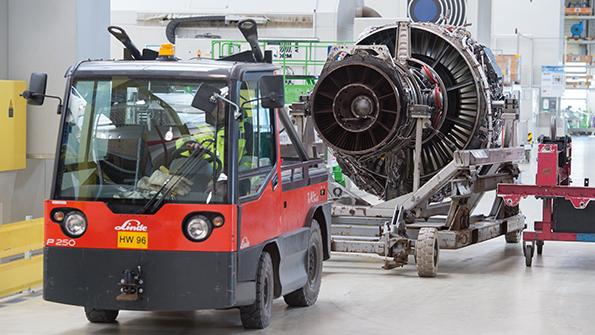
The collapse in airline passenger demand quickly found its way into the engine-overhaul world, with inductions dropping 50% or more in April in some major networks. Engine MRO will recover, but its climb will be complicated by several factors introduced by the sudden glut of airplanes that airlines find on their hands.
First, the good news: Even factoring in the current-generation Leap and PW1000 families, most narrowbody engines are still approaching their prime aftermarket-revenue years. CFM joint-venture partners Safran and GE note that 57% of the combined CFM56-5B and -7B fleet is less than 10 years old, and 62% of it has had one shop visit or none at all.
As traffic recovers, narrowbodies are expected to lead the way as more domestic travel and suppressed long-haul demand maintains pressure on widebodies. This bodes well not just for CFM but also Pratt & Whitney and MTU as well, which lean heavily on the V2500s and PW1100G-JMs that share the Airbus A320ceo and A320neo fleets, respectively, with CFM.
Most of those engines are on long-term agreements. But if aircraft are not flying, that revenue stream slows. GE says its long-term revenue, most of it generated by the CFM product line, could be off by 50% this quarter. Pratt & Whitney parent Raytheon Technologies saw engine inductions plummet 70% in April after what was a largely routine first quarter.
For current-generation platforms that power the most prominent in-production models, recovery will be linked to hours and cycles. Operators of Airbus A220s, A320neos, A350s, Boeing 787s, and—once they are cleared to return—the all-Leap-1B-powered 737 MAX fleet, will be turning to their old standbys, the engine OEMs, for support. But MRO demand from the rest of the fleet could be reshaped by a surge in retirements.
Consultancy AeroDynamic Advisory analyzed the 15,000 aircraft parked as of early May due to the pandemic-related capacity pulldown. Its conclusion? Nearly a third of them, or 4,600 aircraft, are at least 15 years old and many may never return. But engines with green time—life-limited parts with cycles remaining or acceptable exhaust gas temperature margins—are candidates to be cycled back into the fleet.
A similar analysis by Oliver Wyman identified 2,200 aircraft parked during the pandemic that are not likely to return, with the largest chunk, 37%, being narrowbodies. Those retirements will free up about 4,000 engines with at least 90 days of life remaining, says Derek Costanza, a partner at the firm. Most of the available engines will have 1-2 years of life in them before they need overhauls, but some will have up to four years, Costanza says. The combined green-time pool is expected to reduce engine restoration visits 9% for the remainder of 2020 and 7% next year—the equivalent of $1.75 billion in engine overhaul expenses.
The relatively short-lived relief likely means that green-time usage will not eat into MRO revenues for more than a couple of years as demand ramps back up. But its depth will be dictated by both the number and types of aircraft retired. Another factor will be the imminent jump in available used serviceable material, which will lessen reliance on the new-parts market.
“If we do in fact see a surge in retirements, we believe airlines and lessors will have more options regarding engine green time, which could initially limit the uptick in engine MRO activity,” says Canaccord Genuity analyst Ken Herbert. “We continue to view the engine aftermarket as one of the strongest over the cycle . . . but the potential availability of used material can have a direct impact on both component and engine OEMs and spare parts sales into the aftermarket.”
Before the pandemic hit, the aftermarket was pegged to post year-over-year growth somewhere in the high single-digits, at least. Aviation Week’s Commercial Fleet & MRO Forecast had the full market generating $82.5 billion for 2020, with about 40% coming from engine work.
Now such estimates vary widely, all because the pace of recovery is impossible to project. Canaccord says a steady rise in activity in the second half of the year could limit the full-year decline to 25%, with the most significant dip coming during the current quarter. Raytheon says its commercial aftermarket business, which includes Pratt and Collins Aerospace, will be down closer to 50%.
MTU, which arguably has the broadest visibility among manufacturers into the engine MRO market due to its risk-sharing stakes across many platforms, is not looking beyond what it can see.
“You don’t even know exactly how many shop visits you’re going to have in quarter two,” says MTU CEO Reiner Winkler, conveying the challenge of offering even updated full-year guidance. “It’s far too early to speculate.”





